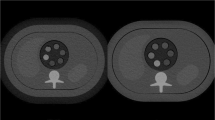Abstract
Objective
The purpose of this study was to compare the time-course of contrast-enhancement in spleen and liver using Exia 160 in comparison with Fenestra LC and VC in healthy mice.
Procedures
Healthy C57bl/6 mice were used in this study. Fenestra LC and VC was administered intravenously at a dose of 0.1 ml/20 g or 0.2 ml/20 g. Exia 160 at a dose of 0.05 ml/20 g or 0.1 ml/20 g. Each animal underwent a micro-CT scan before contrast injection (baseline) and immediately after contrast injection. Additional scans were performed at 1, 2, 3, 4, 24, and 48 h after contrast administration. The mice who received Exia 160 were also scanned after 15, 30, and 45 min.
Results
The peak enhancement of Exia 160 occurred after 15 min for the spleen and after 30 min for the liver.
Conclusions
Exia 160 allows rapid spleen and liver enhancement. The high iodine content results in small injection volumes.






Similar content being viewed by others
References
Wolbarst AB, Hendee WR (2006) Evolving and experimental technologies in medical imaging. Radiology 238:16–39
Badea C, Hedlund LW, Johnson GA (2004) Micro-CT with respiratory and cardiac gating. Med Phys 31(12):3324–3329
Deroose CM, De A, Loening AM, Chow PL et al (2007) Multimodality imaging of tumor xenografts and metastases in mice with combined small-animal PET, small-animal CT, and bioluminescence imaging. J Nucl Med 48:295–303
De Clerck NM, Meurrens K, Weiler H et al (2004) High-resolution X-ray microtomography for the detection of lung tumors in living mice. Neoplasia 6(4):374–379
Paulus MJ, Gleason SS, Kennel SJ et al (2000) High resolution X-ray computed tomography: an emerging tool for small animal cancer research. Neoplasia 2(1–2):62–70
Lewis JS, Achilefu S, Garbow JR et al (2002) Small animal imaging: current technology and perspectives for oncological imaging. Eur J Cancer 38:2173–2188
Weissleder R, Mahmood U (2001) Molecular imaging. Radiology 219:316–333
Hu J, Haworth ST, Molthen RC, Dawson CA (2004) Dynamic small animal lung imaging via a postacquisition respiratory gating technique using micro-cone beam computed tomography. Acad Radiol 11:961–970
Stenström M, Olander B, Carlsson CA et al (1998) The use of microtomography to monitor morphological changes in small animals. Appl Radiat Isot 49(5/6):565–570
Cavanaugh D, Johnson E, Price RE et al (2004) In vivo respiratory-gated micro-CT imaging in small-animal oncology models. Mol Imaging 3(1):55–62
Holdsworth DW, Thornton MM (2002) Micro-CT in small animal and specimen imaging. Trends Biotechnol 20(8):34–39
Massoud TF, Gambhir SS (2003) Molecular imaging in living subjects: seeing fundamental biological processes in a new light. Genes Devl 17(5):545–580
Ford NL, Graham KC, Groom AC et al (2006) Time-course characterization of the computed tomography contrast enhancement of an iodinated blood-pool contrast agent in mice using a volumetric flat-panel equipped computed tomography scanner. Invest Radiol 41:384–390
Kao C-Y, Hoffman EA, Beck KC et al (2003) Long-residence-time nano-scale liposomal iohexol for X-ray-based blood pool imaging. Acad Radiol 10:475–483
Mukundan S, Ghaghada KB, Badea CT et al (2006) A liposomal nanoscale contrast agent for preclinical CT in mice. AJR 186:300–307
Weichert JP, Longino MA, Bakan DA et al (1995) Polyiodinated triglyceride analogs as potential computed tomography imaging agents for the liver. J Med Chem 38:636–646
Weichert JP, Lee FT Jr, Chosy SG et al (2000) Combined hepato-selective and blood-pool contrast agents for the CT detection of experimental liver tumors in rabbits. Radiology 216:865–871
Bakan DA, Weichert JP, Longino MA et al (2000) Polyiodinated triglyceride lipid emulsions for use as hepatoselective contrast agents in CT: effects of physiochemical properties on biodistribution and imaging profiles. Invest Radiol 35:158–169
Weber SM, Peterson KA, Durkee B et al (2004) Imaging of murine liver tumor using micro-CT with a hepatocyte-selective contast agent: accuracy is depentdent on adequate contrast enhancement. J Surg Research 119:41–45
Weichert JP, Lee FT Jr, Longino MA et al (1998) Lipid-based blood-pool CT imaging of the liver. Acad Radiol 5(Suppl 1):S16–S19
Bakan DA, Longino MA, Weichert JP et al (1996) Physicochemical characterization of a synthetic lipid emulsion for hepato-selective delivery of lipophilic compounds: application to polyiodinated triglycerides as contrast agents for computed tomography. J Pharm Sciences 85(9):908–914
Loening AM, Gambhir SS (2003) Amide: a free software tool for multimodality medical image analysis. Mol Imaging 2(3):131–137
Desser TS, Rubin DL, Muller H et al (1999) Blood pool and liver enhancement in CT with liposomal iodixanol: comparison with iohexol. Acad Radiol 6:176–183
Torchilin VP, Frank-Kamenetsky MD, Wolf GL (1999) CT visualization of blood pool in rats by using long-circulating, iodine-containing micelles. Acad Radiol 6:61–65
Suckow CE, Stout DB (2008) MicroCT liver contrast agent enhancement over time, dose, and mouse strain. Mol Imaging Biol 10(2):114–120
Ohta S, Lai EW, Morris JC et al (2006) MicroCT for high-resolution imaging of ectopic pheochromocytoma tumors in the liver of nude mice. Int J Cancer 119:2236–2241
Almajdub M, Nejjari M, Poncet G et al (2007) In-vivo high-resolution X-ray microtomography for liver and spleen tumor assessment in mice. Contrast Media Mol Imaging 2:88–93
Walters EB, Panda K, Bankson JA et al (2004) Improved method of in vivo respiratory-gated micro-CT imaging. Phys Med Biol 49:4163–4172
Author information
Authors and Affiliations
Corresponding author
Rights and permissions
About this article
Cite this article
Willekens, I., Lahoutte, T., Buls, N. et al. Time-Course of Contrast Enhancement in Spleen and Liver with Exia 160, Fenestra LC, and VC. Mol Imaging Biol 11, 128–135 (2009). https://doi.org/10.1007/s11307-008-0186-8
Received:
Revised:
Accepted:
Published:
Issue Date:
DOI: https://doi.org/10.1007/s11307-008-0186-8




